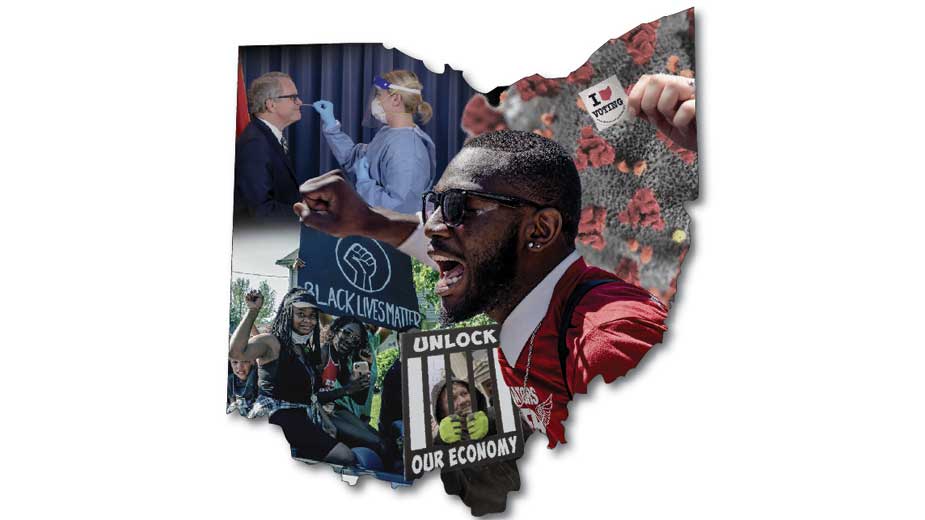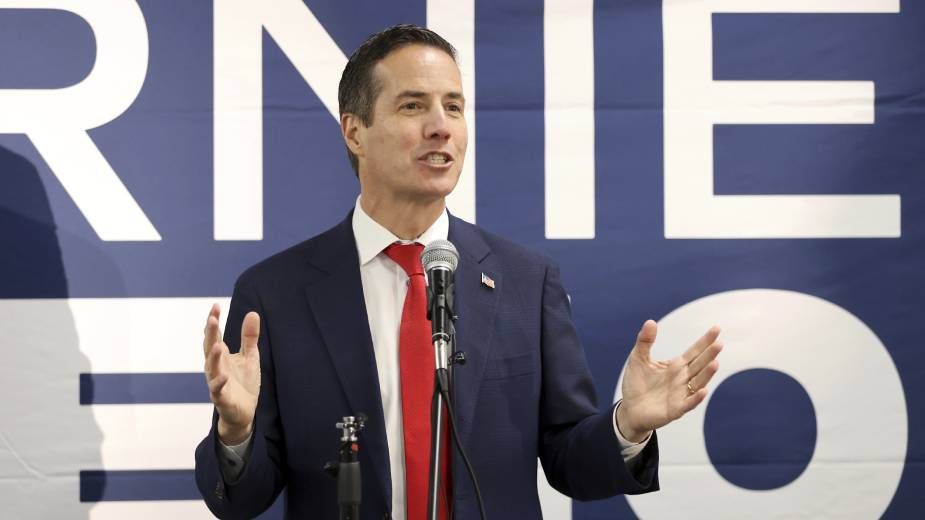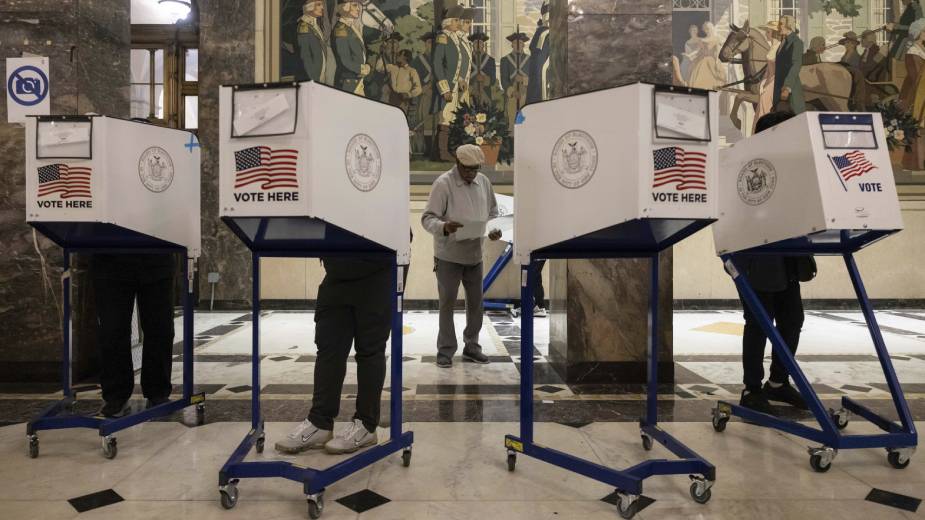‘Your Voice Ohio’ Listens to What Voters Are Saying
By Laura A. Bischoff, Dayton Daily News
Just months before Election Day, voters of all stripes in Ohio are at the same time both worried and hopeful.
They’re not sure who to trust in the media and government. They’re concerned about economic security for themselves and fellow Americans. They aren’t sure how the election will go down during a pandemic. They want honest leaders to come up with more fixes to serious problems.
But at the same time, they are hopeful that the protests are opening eyes to systemic racism, the need for reform and the next generation of leadership. The fact that the protests are drawing black and white, young and old is seen as a sign of unity during a very divisive time in the country. And they’re lifted by seeing small acts of kindness during the pandemic – neighbors helping strangers.
Your Voice Ohio, a collaborative journalism project involving nearly 50 news outlets, held multiple two-hour online conversations in early July with voters from across the state to hear more about what concerns them as the presidential election gets closer and how news media outlets can better provide coverage. Participants, some of whom did not want their names used as they shared personal stories, included single mothers, young dads, workers and retirees, gay and straight, black and white, men and women, old and young.
The conversations revealed that despite Ohio’s diversity, there is plenty of common ground, even during times of intense partisanship and division in our nation.
Ohioans want more from their government and political leaders. They’d like to see fewer personal attacks and more honesty.
“My big issue is honesty. If you can’t believe what’s coming out of their mouths, it doesn’t matter,” said one Licking County woman. Alah Jackson of Columbus agreed, citing fairness and honesty as high priorities for her.
They also want leaders who will unite the country. Nick Schroeder, a retired accounting professor in Bowling Green, said, “I’m really interested in things about bringing us together. How much people and candidates are actually going to try to bring us together, rather than the ‘here’s my viewpoint, which is much better than your viewpoint.’”
When asked how leaders might bridge the political divides seen in the United States today, Jonathan Chu of suburban Columbus said, “I don’t think either side is interested in bridging divides. They want to make it a bigger divide and grab a bigger piece.”
There is a strong current of mistrust of the government.
“I don’t think mail-in voting is a good idea because I don’t trust people, especially a lot of people in the government right now,” said Brhiannon Riddle, a 25-year-old single mother who lives in a small town north of Dayton.
A Cincinnati area voter said faith and trust in the voting system is paramount and he doesn’t appreciate rhetoric that undermines that.
Jo’el Jones, a Dayton woman who ran for state representative in the Democratic primary, said closing the polls to in-person primary voting at the last minute and shifting to extended absentee voting during the pandemic was chaotic and caused a lot of people to miss the chance to vote. She’s worried that Ohio won’t be ready for November, especially if the pandemic continues.
“I don’t know. It’s a damn mess,” she said.
Roger Davis of Cambridge, a long-time elections worker, said he is worried county boards of elections will be swamped with a massive upswing in requests for absentee ballots this fall and they’ll have difficulty finding poll workers. “It concerns me for sure.”
‘I’m tired of media bias’
And Ohioans want more from journalists. They are thirsty for more fact-checking and issues stories, less political bias, the inclusion of diverse voices in stories, more accurate headlines and fewer typos and spelling mistakes.
Reghan Buie of Youngstown, a first-time voter, said she hunted for hours for local news stories about candidates on her primary ballot but found very little. “There should be more information about local races because they matter.”
Others went further and said they don’t care if their local outlets cover the presidential election – they can get that coverage from national outlets. Instead, the focus should be on state and local stories and issues, they said.
And many Ohioans are skeptical of media.
“I’m tired of media bias. I want to hear all the facts. I think that you can be dishonest by communicating the facts but not all of them and also by taking things out of context.
Where is Walter Cronkite when you need him? He used to just give us the news and let us make up our own minds. Today it is a blood bath out there,” said one Toledo area retiree.
Later in the conversation, the same woman added: “I feel that the media is our biggest problem right now and I think there are a lot of reasons for it. There’s not a lot of money in being a reporter. It seems like locally if you just give a press release to someone, they typically just use it without understanding the whole picture. They’re just covering so much and they have little time that they’re not investigative reporters anymore – at any level.”
Although they all said the pandemic is top of mind, participants named the economy, health care, environment, education and equality as their top issues in the 2020 election season.
Michelle Anderson of Wooster said the temptation to pick one top issue ignores the fact that so many issues are interconnected. “All of these things go together and can benefit us all. Health care needs are related to job needs, and jobs and minimum wage are related education opportunities, and where we can live, to better schools. We make it lot of little things and need to look at all those things as a whole.”
Fred Camden, of Springfield, maintains that President Trump has brought good paying jobs to the country. Camden retired after 40 years as a letter carrier – a job that was once a ticket to the middle class. “A good job is out there if you really want one,” he said.
Riddle, though, said it’s not that easy. She got into a government-subsidized job-training program to help her land a customer service job that pays $13 an hour.
“Still, at 40 hours a week, $13 an hour, I am at the point where I’m stuck in the middle. Welfare isn’t going to help me anymore because I make just enough that I’m over it (the eligibility threshold) but I also can’t afford to live on the rest,” said Riddle, a single mother. She still works part-time at her old job at a hotel making $9 an hour.
Carol Lynn, a mother of two in Dayton, said her mom worked at General Motors and was able to support her family but those automaker jobs are long gone. She said the government needs to provide job training programs to boost workers into higher-paying positions.
One Hamilton County man who is the son of immigrants said his parents started a business and sacrificed for their children to have opportunities.
“Sometimes I think the government needs to support society and make sure those opportunities are available. Other times, I think the government needs to get out of the way and let people be their best self as well,” he said.
Pandemic affects all Ohioans
Nearly everyone is impacted by the coronavirus pandemic – either directly or indirectly.
“COVID-19 turned my life upside down, around and probably back. I feel like I was on a rollercoaster at Cedar Point,” said Indya Elie of Northeast Ohio.
In March, when the governor shut down Ohio, Elie and her two children shifted to online learning. She came down with COVID symptoms but couldn’t get a test at the time. “I have to be on my death bed to be tested,” she said. Nonetheless, she pushed through, got well, finished her semester, helped her sons with online schoolwork and applied for unemployment benefits, she said.
Another woman from central Ohio said she left her college campus in March and didn’t return. She graduated in May, watching the ceremony on YouTube in her living room and has limited her outings to protect her health. “It completely changed how I interact with the world.”
While some Ohioans resist wearing masks, others see the public health benefit of doing so.
Schroeder, from Bowling Green said, “People without masks all over the place scare the hell out of me.” The coronavirus mask issue prompted him to write a letter to his city councilman, asking for quick action on a mask mandate, he said.
“I definitely think that folks that are not wearing masks or shouting at people who tell them to put their masks on are ridiculous,” said Josh Culling, a father of two young boys in the Toledo area. “I think this whole talk of freedom and tyranny of being made to wear a mask is ridiculous. I also think it’s ridiculous that we need to shut down schools completely forever until we get a vaccine.”
Another Toledo area resident said, “I don’t understand how people get so angry over the situation. It’s a mask and I don’t want to minimize it. It’s uncomfortable. Think of Anne Frank in World War II and what she went through. What we’re asked to do during this pandemic is nothing.”
COVID pulled back the curtain on health care disparities for the public – something Adrienne Zurub of Cleveland has seen for a long time as a registered nurse. Zurub said for many Black people, it’s just six degrees of separation to knowing someone who died of COVID-19.
“That really hits home and again it exposes the disparity in health care that we’ve experienced in health care since we touched these shores,” said Zurub, who is retired. “…Everyone thinks that we have the greatest health care system in the world. We don’t. When you’re telling nurses and front-line workers to put on a bandana and a scarf and a garbage bag and go out and essentially sacrifice yourself – that should say something.”
Protests elevate racial justice issues
The recent protests over police brutality have elevated the issues of racial injustice for many Ohioans.
Jo’el Jones said oppressive public policies have long been her top priority. She worries about raising two Black sons and what might happen to them when they get their driver’s licenses or go out for a run.
Mykell Rose, a gay biracial man from Hamilton County, said equality issues have become a top priority for him.
And Carol Lynn of Dayton, a mother of a Black son, said the video of George Floyd’s killing brought the issue of racial justice to the forefront for her.
It’s not just Black Ohioans who care about Black Lives Matters.
“I’ve learned a lot the past few months and I have educated myself. I’ve educated my children. I think there needs to be more formal education with our history and not so much the white-washed history I had as a child,” said Stacy Dodson, a white woman in Wheelersburg. “My eyes were opened to what was going on in the world and my heart was broken.”
Rick Phelps, a retired EMT and law enforcement officer who lives in Southeast Ohio, said he is worried about the outcome of the November election. “I never would have dreamed four or five months ago, we’d be talking about defunding the police. It is unfathomable to me,” he said, adding, “I just cannot believe where one party is and the other party is. We’re supposed to be working together here. We aren’t African-Americans, we’re not Asian-Americans. We are Americans, first and foremost.”
Despite the challenges of the protests and pandemic, both are a source of hope for Ohioans.
Carol Lynn of Dayton said she was encouraged to see Blacks, whites, young, old all protesting against racism and injustice. “It’s a united front fighting against these issues and that the young people are taking the lead,” she said.
Jo’el Jones of Dayton is hopeful the protests will bring real reform. “The ugliness of racism and fear is exposed and because it is exposed there is outright anger. And out of all of this, leaders will arise. The way we look, talk and even politic will be very different. I think out of all of this, I’ll get that courageous leader that I pray to come soon.”
Michelle Anderson of Wooster said she likes that Ohioans – and business owners – are starting to stand up against displaying the Confederate flag. She sees it as a recognition of the pain that the flag causes. “That gives me hope.”
Others say they’re lifted by seeing acts of kindness – people delivering meals, crafters making homemade masks, donors contributing to food banks – during the pandemic. “The pandemic has brought out the best in people in a lot of ways. I think we’ve all seen that with people helping neighbors,” said one Toledo area woman.
And Reghan Buie said she believes the next generation is ready to step up and lead.
“We are coming for the Senate, we are coming for the House. We’re coming for everything. We want to improve this nation.”
While there is tremendous division in America, Ohioans recognize the value in hearing from those who hold different opinions.
Josh Culling said he moved back to his hometown of Toledo in part because of its diversity. He celebrates that inside a Toledo bar he can find hourly workers, professionals, Muslims, Christians, Republicans, Democrats sitting together. He described it as a chance to venture “outside my little bubble.”
Roger Davis, a Cambridge man who works for a non-profit, said he consumes stories from multiple media outlets but would like to hear more voices in those news stories from people who hold different political views.
“Sometimes it’s good to be challenged in your ideas. I don’t necessarily always like to hear what I already think I know. Sometimes I like to see the other point of view, even if I disagree with it, I like to now other people are being heard,” he said.
The author, Laura Bischoff, is the statehouse reporter for the Dayton Daily News, Springfield News-Sun and Hamilton-Middletown Journal-News. She can be emailed at [email protected]
Illustration at top by Cameron Peters, KentWired
RELATED STORY: Voting, Pandemic Are Top Concerns During Northeast Ohio Listening Session
COMING MONDAY: New poll results on presidential race in Ohio.
— About the project: Your Voice Ohio is the largest sustained, statewide media collaborative in the nation. Launched nearly five years ago, more than 60 news outlets have participated in unique, community-focused coverage of elections, addiction, racial equity, the economy and housing. Nearly 1,300 Ohioans have engaged with more than 100 journalists in dozens of urban, rural, and suburban communities across the state. Over and over again, Ohioans have helped journalists understand their perspectives and experiences while sharing ideas to strengthen their local communities and the state. Doug Oplinger, formerly of the Akron Beacon Journal, leads the media collaboration. The Democracy Fund, John S. and James L. Knight Foundation, and Facebook are the primary funders of Your Voice Ohio. The Jefferson Center for New Democratic Practices, a non-partisan non-profit engagement research organization, designs and facilitates Your Voice Ohio community conversations.
Published by The Business Journal, Youngstown, Ohio.



